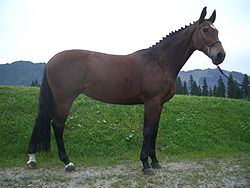Bavarian Warmblood
| Bavarian Warmblood | |
|---|---|

Bavarian Warmblood |
|
| Important data | |
| Origin: | Rottal Bavaria |
| Main breeding area: | Bavaria, England |
| Distribution: | low, in Germany approx. 140 stallions, approx. 4000 broodmares |
| Stick measure : | 162-175 cm |
| Colors : | mostly browns and foxes, more rarely black horses and gray horses |
| Main application area: | Sport horse, riding horse and farm horse |
| Branding | |

|
|
The Bavarian Warmblood is an old German breed of horses, breeding them over time - similar to the Württemberger Warmblood - subject of a checkered history.
Background information on horse evaluation and breeding can be found under: Exterior , interior and horse breeding .
Exterior
The Bavarian Warmblood is a medium-sized horse that resembles the Hanoverian in exterior .
The head is of medium size, the long neck arises from a sloping shoulder, which underlines the riding horse points with the well-defined withers. The torso should have a good depth and width and the back should be stable and merge into a strong loin area. The breeding program values a correct foundation .
The mechanics are good in all basic gaits, the jumping ability is average to good.
Breeding history
The breed probably developed out of heavy economic horses influenced by the Noriker , among others . In addition, attempts were made to establish a lighter workhorse in rural stables by making warmblood stallions available free of charge as stallions (especially Oldenburgers), with the aim of having suitable remonts (agile, strong, in muted colors) used for the military in peasant stables . This motivated, strong but not heavy warmblood horse was only popular as an economic horse in the Rottal until the Second World War and was therefore known as the Rottal horse .
After the Second World War and the change in the breeding goal to focus on sport horses, the old type of warmblood was lost. At the beginning of the 1960s, horses from other German breeding areas, especially Hanoverians and Westphalia , as well as horses from France and the Netherlands were crossed on a large scale in order to improve their jumping ability over the long term. In addition, Trakehner and thoroughbreds were used for refinement . The homogeneous Rottaler Warmblood , which was formerly mainly used in agriculture and had the type of a heavy warmblood , was not slowly refined, but rather radically replaced by an initially very heterogeneous modern sport horse. Unfortunately, along with all of the genetic resources, the valuable traits that were painstakingly bred into mare lines, such as robustness, longevity and motivation, were lost and had to be rebuilt.